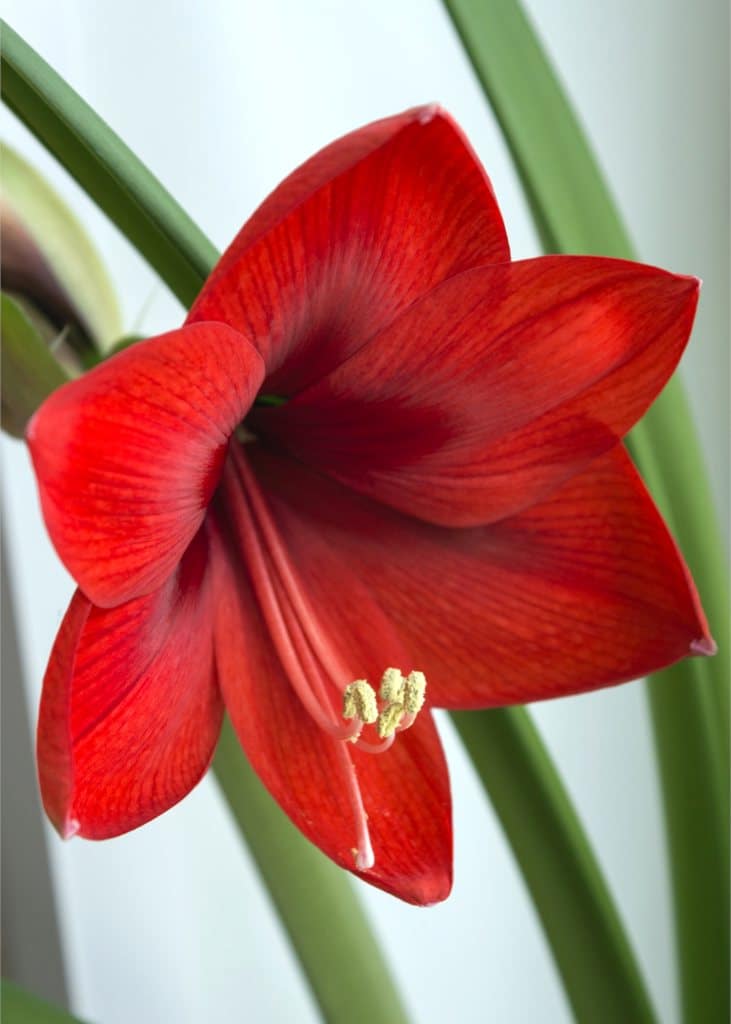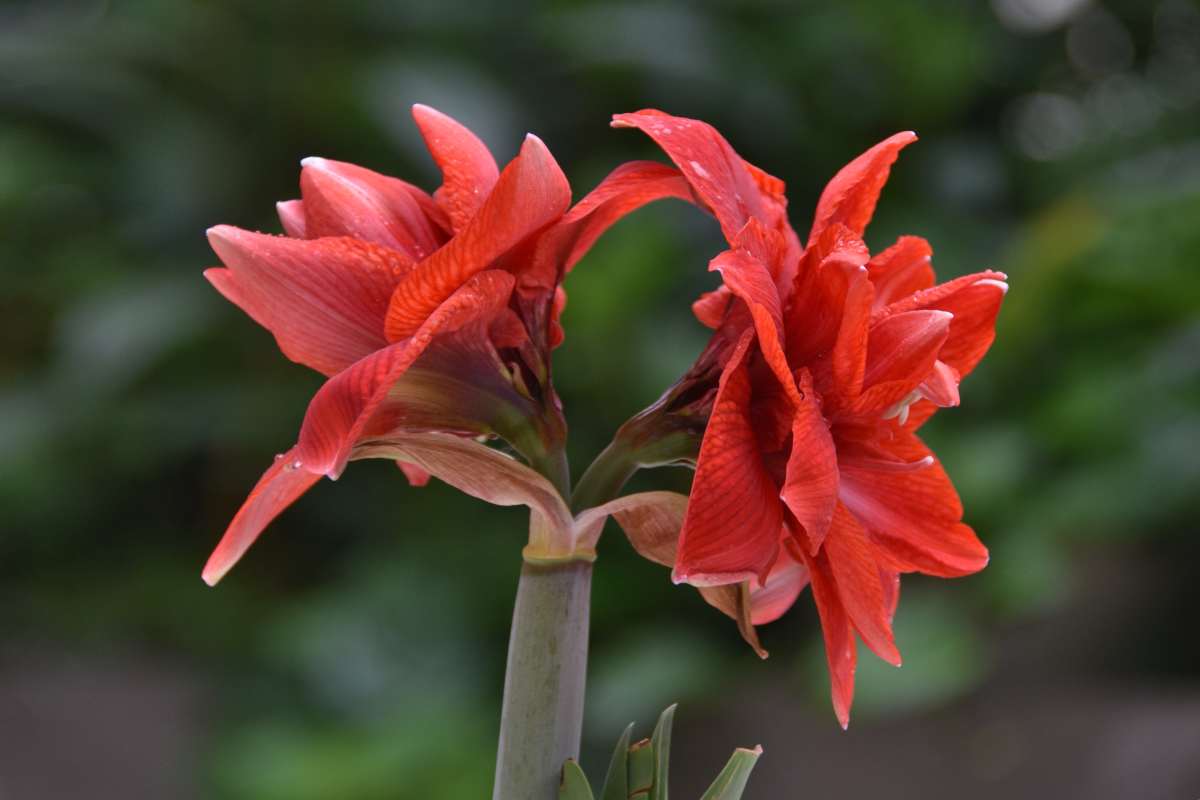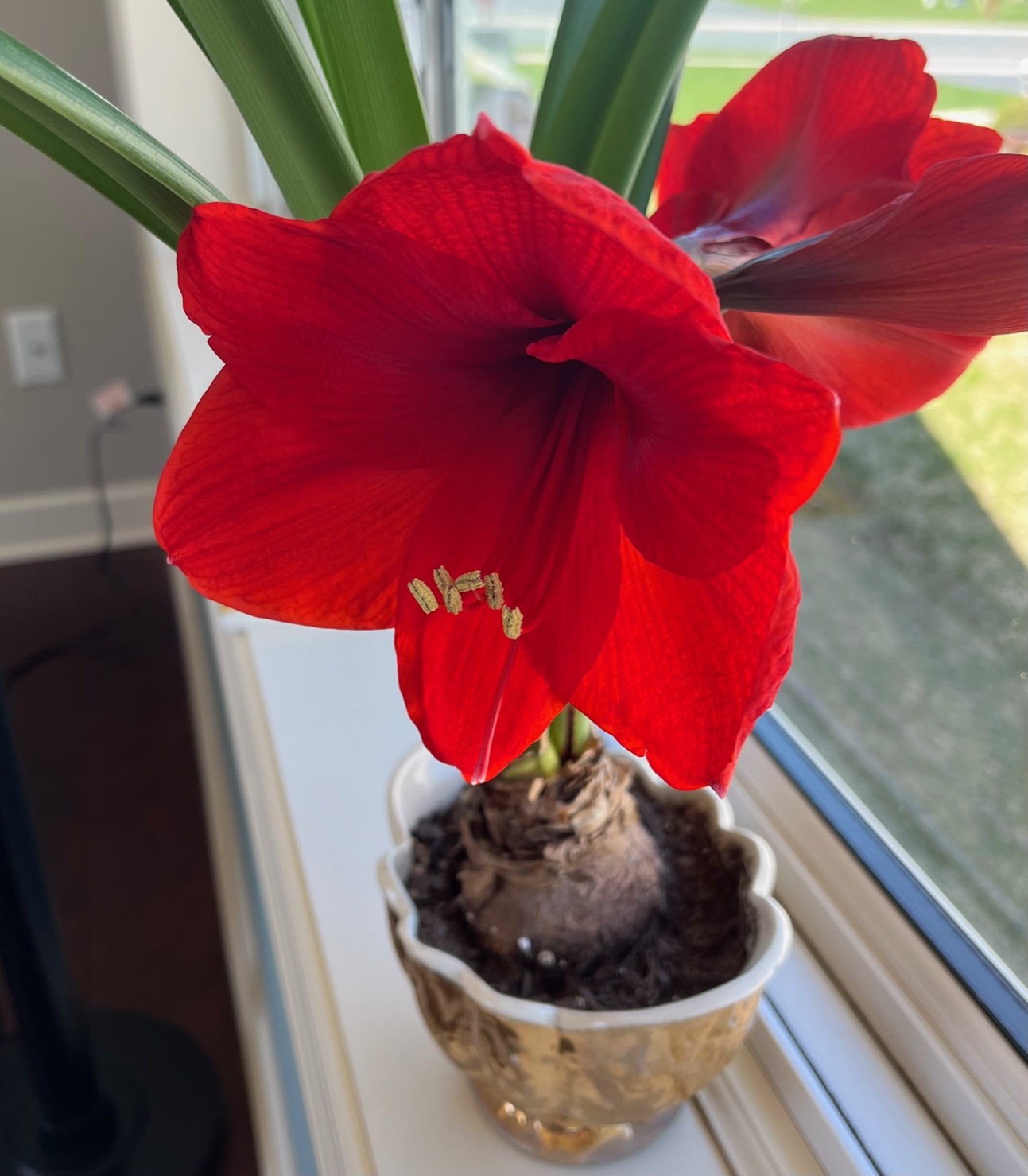Understanding the Amaryllis Life Cycle
The amaryllis plant’s life cycle is a fascinating process that involves several stages, from the initial bulb to the final bloom. To successfully grow an amaryllis, it’s essential to understand these stages and provide the necessary care and attention. The life cycle of an amaryllis plant can be divided into three main stages: dormancy, growth, and blooming.
During the dormancy stage, the bulb is in a state of rest, and the plant is not actively growing. This stage typically lasts for 2-3 months and is crucial for the plant’s development. After the dormancy period, the bulb begins to sprout, and the growth stage commences. During this stage, the plant produces leaves and roots, and the bulb starts to swell.
As the plant continues to grow, it eventually reaches the blooming stage. This is the most exciting part of the amaryllis life cycle, as the plant produces large, showy flowers that can last for several weeks. However, the blooming stage can be unpredictable, and the time it takes for an amaryllis to bloom from a bulb can vary depending on several factors, including temperature, light, water, and fertilization.
Understanding the amaryllis life cycle is crucial for providing the necessary care and attention to ensure successful blooming. By recognizing the different stages of the plant’s life cycle, growers can adjust their care routine to meet the plant’s specific needs, ultimately leading to a healthier and more vibrant bloom.
For those wondering how long it takes for an amaryllis to bloom from a bulb, the answer can vary. On average, it can take anywhere from 6-12 weeks for an amaryllis to bloom after planting. However, this timeframe can be influenced by the factors mentioned earlier, and some varieties may bloom faster or slower than others.
By understanding the amaryllis life cycle and providing the necessary care and attention, growers can enjoy the beauty and elegance of these stunning flowers. Whether you’re a seasoned gardener or a beginner, growing an amaryllis can be a rewarding experience that brings joy and beauty to your home.
Factors Affecting Blooming Time: What You Need to Know
When it comes to growing amaryllis, one of the most common questions is “how long for amaryllis to bloom from bulb?” The answer to this question can vary depending on several factors that influence the time it takes for an amaryllis to bloom. Understanding these factors can help you provide the best conditions for your amaryllis to thrive and bloom.
Temperature is one of the most significant factors affecting blooming time. Amaryllis plants typically require a period of cooler temperatures to induce blooming. If the temperature is too high, it can delay or prevent blooming. On the other hand, if the temperature is too low, it can slow down the growth process. The ideal temperature for amaryllis growth is between 65-75°F (18-24°C).
Light is another crucial factor that affects blooming time. Amaryllis plants require bright, indirect light to bloom. If the light is too intense, it can cause the leaves to become scorched, while too little light can prevent blooming. East- or west-facing windows are ideal for amaryllis plants.
Watering is also a critical factor that affects blooming time. Over-watering can lead to root rot and prevent blooming, while under-watering can cause the plant to become stressed. It’s essential to water your amaryllis plant carefully, making sure the soil is moist but not waterlogged.
Fertilization is also important for promoting healthy growth and blooming. A balanced fertilizer can provide the necessary nutrients for your amaryllis plant to thrive. However, it’s essential to avoid over-fertilizing, as this can damage the plant.
By understanding these factors and providing the right conditions, you can encourage your amaryllis plant to bloom. On average, it can take anywhere from 6-12 weeks for an amaryllis to bloom from a bulb. However, this timeframe can vary depending on the specific variety, growing conditions, and care.
Some amaryllis varieties are bred to bloom faster than others. For example, ‘Red Lion’ and ‘Apple Blossom’ are known to bloom in as little as 6-8 weeks, while ‘Ferrari’ can take up to 12 weeks to bloom. By choosing a variety that is known to bloom quickly, you can enjoy the beauty of your amaryllis plant sooner.
How to Plant and Care for Your Amaryllis Bulb
Planting and caring for an amaryllis bulb requires attention to detail and a understanding of the plant’s specific needs. By following these steps, you can help your amaryllis bulb thrive and bloom.
Choosing the right potting mix is essential for amaryllis growth. A well-draining potting mix that is rich in organic matter will help to prevent waterlogged soil and root rot. A mix specifically designed for bulbs is ideal.
Planting the bulb is a straightforward process. Start by selecting a pot that is slightly larger than the bulb. Fill the pot with potting mix, leaving about an inch at the top for watering. Place the bulb in the pot, making sure the base of the bulb is level with the soil surface. Add a layer of potting mix around the bulb, firming it gently to secure the bulb in place.
Watering is critical for amaryllis growth. Water the bulb thoroughly after planting, and then allow the soil to dry slightly between waterings. Over-watering can lead to root rot, while under-watering can cause the plant to become stressed.
Providing the right amount of light is also essential for amaryllis growth. Amaryllis plants prefer bright, indirect light, but direct sunlight can cause the leaves to become scorched. East- or west-facing windows are ideal for amaryllis plants.
Fertilization is also important for promoting healthy growth and blooming. A balanced fertilizer can provide the necessary nutrients for your amaryllis plant to thrive. However, it’s essential to avoid over-fertilizing, as this can damage the plant.
By following these steps and providing the right care, you can help your amaryllis bulb thrive and bloom. Remember to be patient, as it can take several weeks for the bulb to bloom. On average, it can take anywhere from 6-12 weeks for an amaryllis to bloom from a bulb, depending on the specific variety and growing conditions.
Some additional tips to keep in mind when caring for your amaryllis bulb include:
- Keep the pot away from drafts and extreme temperatures.
- Avoid getting water on the bulb or leaves to prevent rot and other diseases.
- Repot the bulb every 2-3 years to provide fresh potting mix and a larger pot if necessary.
By following these tips and providing the right care, you can enjoy the beauty of your amaryllis bloom for weeks to come.
The Waiting Game: How Long Until My Amaryllis Blooms?
One of the most common questions asked by amaryllis enthusiasts is “how long for amaryllis to bloom from bulb?” The answer to this question can vary depending on several factors, including the specific variety, growing conditions, and care.
On average, it can take anywhere from 6-12 weeks for an amaryllis to bloom from a bulb. However, this timeframe can be influenced by the factors mentioned earlier, and some varieties may bloom faster or slower than others.
Here’s a general outline of what to expect during the blooming process:
- Week 1-2: The bulb begins to sprout, and the first leaves emerge.
- Week 3-4: The plant continues to grow, and the leaves become more prominent.
- Week 5-6: The flower stalk begins to emerge, and the buds start to form.
- Week 7-12: The flowers bloom, and the plant reaches its full height.
It’s essential to remember that every amaryllis plant is unique, and the blooming process can vary depending on the specific variety and growing conditions. Some varieties, such as ‘Red Lion’ and ‘Apple Blossom’, are known to bloom faster than others, while ‘Ferrari’ may take a bit longer.
During the waiting period, it’s crucial to provide the right care and attention to your amaryllis plant. This includes watering, fertilizing, and providing the right amount of light. By following these tips and being patient, you can enjoy the beauty of your amaryllis bloom for weeks to come.
Some additional tips to keep in mind during the waiting period include:
- Keep the pot away from drafts and extreme temperatures.
- Avoid getting water on the bulb or leaves to prevent rot and other diseases.
- Repot the bulb every 2-3 years to provide fresh potting mix and a larger pot if necessary.
By following these tips and being patient, you can enjoy the beauty of your amaryllis bloom and make the most of this special moment.
Common Mistakes to Avoid When Growing Amaryllis
While growing amaryllis can be a rewarding experience, there are several common mistakes that can delay or prevent blooming. By understanding these mistakes and taking steps to avoid them, you can increase your chances of success and enjoy the beauty of your amaryllis bloom.
One of the most common mistakes is over-watering. Amaryllis bulbs are prone to rot if the soil is too wet, which can prevent blooming. To avoid this, make sure to water your amaryllis plant carefully, allowing the soil to dry slightly between waterings.
Under-fertilizing is another common mistake. Amaryllis plants require a balanced fertilizer to promote healthy growth and blooming. Make sure to fertilize your amaryllis plant regularly, following the instructions on the fertilizer package.
Inadequate light is also a common mistake. Amaryllis plants require bright, indirect light to bloom. If the light is too low, the plant may not produce flowers. Make sure to place your amaryllis plant in a spot with plenty of indirect light, such as an east- or west-facing window.
Another mistake is not providing enough support for the plant. Amaryllis plants can grow quite tall, and may require staking to prevent them from toppling over. Make sure to provide support for your amaryllis plant as it grows, using stakes or a trellis if necessary.
Finally, not allowing the plant to rest is a common mistake. Amaryllis plants require a period of rest after blooming, during which time they should not be watered or fertilized. Make sure to allow your amaryllis plant to rest after blooming, as this will help it to recharge and produce new growth.
By avoiding these common mistakes, you can increase your chances of success and enjoy the beauty of your amaryllis bloom. Remember to be patient, as growing amaryllis can take time and effort. With proper care and attention, you can enjoy the beauty of your amaryllis bloom for weeks to come.
Some additional tips to keep in mind when growing amaryllis include:
- Keep the pot away from drafts and extreme temperatures.
- Avoid getting water on the bulb or leaves to prevent rot and other diseases.
- Repot the bulb every 2-3 years to provide fresh potting mix and a larger pot if necessary.
By following these tips and avoiding common mistakes, you can enjoy the beauty of your amaryllis bloom and make the most of this special moment.
Encouraging Re-Blooming: Tips and Tricks
After an amaryllis plant has finished blooming, it’s not uncommon for growers to wonder how to encourage it to re-bloom. With proper care and attention, an amaryllis plant can be encouraged to produce new flowers, and even bloom again in the same season.
One of the most important things to do after an amaryllis plant has finished blooming is to cut back the flower stalk. This will help the plant to conserve energy and direct it towards producing new growth. Cut the stalk back to about an inch above the bulb, and make sure to remove any dead or dying leaves.
Next, it’s essential to provide the plant with a period of rest. This means reducing watering and fertilization, and allowing the plant to dry out slightly between waterings. This will help the plant to recharge and prepare for new growth.
After the plant has rested for a few weeks, it’s time to start encouraging new growth. This can be done by increasing watering and fertilization, and providing the plant with plenty of bright, indirect light. You can also try pruning the leaves to encourage new growth and promote a bushy shape.
Another way to encourage re-blooming is to provide the plant with a cooler temperature. Amaryllis plants typically require a period of cooler temperatures to induce blooming, so try placing the plant in a cooler location, such as a basement or garage.
Some additional tips to keep in mind when encouraging re-blooming include:
- Make sure the plant is receiving enough light. Amaryllis plants require bright, indirect light to bloom.
- Avoid over-watering, as this can prevent the plant from blooming.
- Provide the plant with a balanced fertilizer to promote healthy growth and blooming.
By following these tips and providing the right care and attention, you can encourage your amaryllis plant to re-bloom and enjoy the beauty of its flowers again.
Some popular amaryllis varieties that are known to re-bloom well include ‘Red Lion’, ‘Apple Blossom’, and ‘Ferrari’. These varieties are known for their ability to produce multiple flowers per stem, and can be encouraged to re-bloom with proper care and attention.
Amaryllis Varieties: Which Ones Bloom the Fastest?
When it comes to growing amaryllis, one of the most common questions is “how long for amaryllis to bloom from bulb?” While the answer to this question can vary depending on several factors, some amaryllis varieties are known to bloom faster than others.
One of the fastest-blooming amaryllis varieties is ‘Red Lion’. This variety is known for its bright red flowers and can bloom in as little as 6-8 weeks from planting. ‘Red Lion’ is a popular choice among amaryllis enthusiasts due to its vibrant color and fast-blooming habit.
Another fast-blooming variety is ‘Apple Blossom’. This variety produces delicate, pink flowers and can bloom in as little as 7-9 weeks from planting. ‘Apple Blossom’ is a great choice for those who want a more subtle, pastel-colored bloom.
‘Ferrari’ is another popular amaryllis variety that is known for its fast-blooming habit. This variety produces bright red flowers with a yellow center and can bloom in as little as 8-10 weeks from planting. ‘Ferrari’ is a great choice for those who want a bold, vibrant bloom.
Other fast-blooming amaryllis varieties include ‘Minerva’, ‘Mont Blanc’, and ‘Raspberry’. These varieties are known for their unique characteristics and fast-blooming habits, making them a great choice for those who want to enjoy the beauty of their amaryllis bloom as soon as possible.
When growing amaryllis, it’s essential to remember that the blooming time can vary depending on several factors, including temperature, light, water, and fertilization. By providing the right conditions and care, you can encourage your amaryllis plant to bloom faster and enjoy the beauty of its flowers for weeks to come.
Some additional tips to keep in mind when growing amaryllis include:
- Make sure the plant is receiving enough light. Amaryllis plants require bright, indirect light to bloom.
- Avoid over-watering, as this can prevent the plant from blooming.
- Provide the plant with a balanced fertilizer to promote healthy growth and blooming.
By following these tips and choosing a fast-blooming amaryllis variety, you can enjoy the beauty of your amaryllis bloom in no time.
Conclusion: Enjoying the Beauty of Your Amaryllis Bloom
With the right care and attention, an amaryllis plant can provide a stunning display of color and beauty. By understanding the different stages of the amaryllis life cycle, from bulb to bloom, and providing the right conditions, you can enjoy the beauty of your amaryllis bloom for weeks to come.
Remember, patience is key when growing amaryllis. It can take several weeks for the bulb to bloom, but the end result is well worth the wait. By following the tips and advice outlined in this article, you can encourage your amaryllis plant to bloom and enjoy the beauty of its flowers.
Some final tips to keep in mind when enjoying the beauty of your amaryllis bloom include:
- Make sure to provide the plant with plenty of bright, indirect light to promote healthy growth and blooming.
- Avoid over-watering, as this can prevent the plant from blooming.
- Provide the plant with a balanced fertilizer to promote healthy growth and blooming.
By following these tips and enjoying the beauty of your amaryllis bloom, you can make the most of this special moment and enjoy the beauty of your plant for weeks to come.
Whether you’re a seasoned gardener or a beginner, growing amaryllis can be a rewarding and enjoyable experience. With the right care and attention, you can enjoy the beauty of your amaryllis bloom and make the most of this special moment.







:strip_icc()/Magic-Green-Amaryllis-4c645d541305498eb24078b8c24b6b68.jpg)
